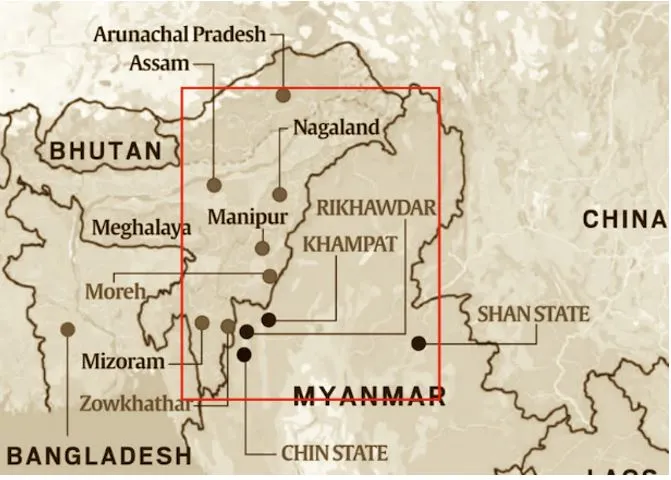

5th May 2025 (11 Topics)
Context
The United Naga Council (UNC) has demanded the reinstatement of the Free Movement Regime (FMR) along the India-Myanmar border, following its scrapping by the Indian government in February 2023, which disrupted the cultural and economic ties of the Naga communities living across the border. The UNC also seeks the rollback of districts created in 2016, which it argues disregarded the rights of the Naga people.
What was FMR?
- The Free Movement Regime (FMR) allowed individuals from certain hill tribes in India and Myanmar to move freely across the border without a visa, provided they lived within 16 km of the border.
- They were allowed to stay for up to two weeks per visit.
- This system helped maintain cross-border interactions, especially for the Naga communities who have lived in these border regions for generations.
- In 2023, the Ministry of Home Affairs decided to scrap the FMR, citing security concerns, such as the prevention of arms smuggling, drug trafficking, and illegal immigration.
- The UNC argues that this decision severed the historical, cultural, and familial ties between the Naga people on both sides of the border.
- Impact on the Naga Communities: The removal of the FMR has created disruptions in the lives of many Naga tribes, especially those from the Tangkhul, Anal, Moyon, Lamkang, and Maring Naga communities.
- These communities live in the border areas between Manipur (India) and the Sagaing Division (Myanmar).
- Their livelihoods, which have historically relied on cross-border trade, familial connections, and cultural exchange, have been severely affected.
- Violation of Indigenous Rights: The UNC argues that the scrapping of the FMR violates Article 36 of the United Nations Declaration on the Rights of Indigenous Peoples (2007).
- This article states that indigenous peoples, especially those divided by international borders, have the right to maintain and develop cross-border relationships for cultural, social, and economic purposes.
- While India did not sign this declaration, it did vote in favor of its adoption, adding weight to the UNC's argument.
- The removal of the FMR, according to the UNC, disrupts these fundamental rights of the Naga people.
The Creation of New Districts in 2016:
- In 2016, the Manipur state government created seven new districts.
- These new districts—Jiribam, Kamjong, Kakching, Tengnoupal, Noney, Pherzawl, and Kangpokpi—were carved out from existing districts, such as Ukhrul, Senapati, Chandel, and Tamenglong, which are areas with a significant Naga population.
- Naga Opposition: The Naga community strongly opposed the creation of these districts, arguing that the move ignored their stakeholders and violated previous agreements.
- The UNC highlights that the creation of these districts dishonored memoranda of understanding between the government and Naga groups, as well as an assurance given by the Centre in 2011 to maintain the status quo regarding the administrative boundaries.
Myanmar Border Sharing
 |

